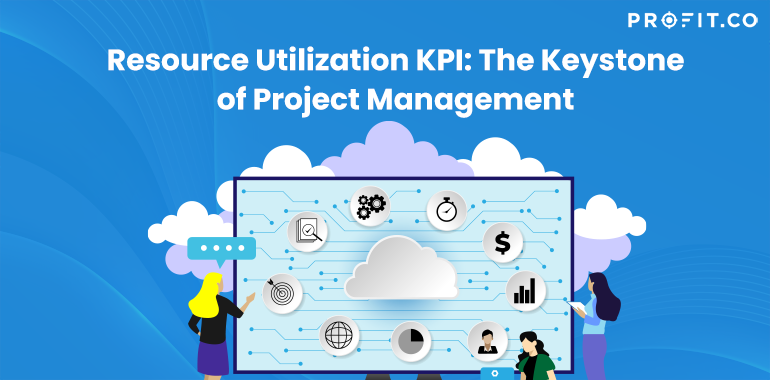Understanding Resource Utilization in Project Management
Resource Utilization in project management measures how much productive work your resources do instead of how much they could be doing. It asks, “Are we leveraging our assets to their fullest potential?”
Resource Utilization answers some critical questions, like
- Is our team performing at its peak capability?
- Are we overburdening some while others are idle?
- Are we aligning our resource spending with our project’s success?
“The ultimate resource in economic development is people. It is people, not capital or raw materials that develop an economy.”
Advantages of Tracking Resource Utilization
By understanding how resources are used, you can make better decisions about allocation, budgeting, and project planning. Identifying underutilized resources and optimizing workflows can lead to significant productivity gains in resource management.
1.Strategic resource allocation
By understanding each team member’s capacity, managers can distribute tasks more effectively, preventing overburdening and underutilization. Tools like capacity heat maps can visually aid this process.
2.Elevated productivity
Regularly review resource utilization rates to identify idle or underutilized team members. Utilize project management software to swiftly reassign them to areas requiring more support, thus enhancing overall productivity.
3.Streamlined cost efficiency
Use resource utilization data to identify areas where resources are wasted, allowing for reallocation or downsizing. This precision reduces idle time, translating to a healthier bottom line.
4.Data-driven decision-making
Managers can make informed decisions armed with precise utilization data and decisions about hiring, training, and resource management, ensuring the right skills are deployed where they are most needed.
5.Insightful performance metrics
Comparing current utilization with historical data or industry benchmarks provides clear insights into performance. This helps recognize patterns, predict future needs, and set benchmarks for continuous improvement.
Ready to optimize your resource utilization and unlock hidden efficiency within your organization?
Calculating Resource Utilization
Calculating Resource Utilization involves measuring the percentage of time resources are actively engaged in productive tasks. This is typically done by dividing the actual working hours of resources by their total available hours, providing a clear picture of how effectively resources are utilized in an organization
Resource utilization can be calculated in two ways
1. Individual-Resource Utilization:
This measures the percentage of time an individual resource is actively working on assigned tasks.
Formula:
Individual-Resource Utilization = (Actual Working Hours / Total Available Hours) x 100%
Actual Working Hours: The total number of hours spent on assigned tasks during a specific period.
Total Available Hours: The total number of hours a resource is available to work during a specific period (typically calculated based on work schedule and paid time off).
2. Project Resource Utilization:
This measures the percentage of time all resources assigned to a project are actively working on project tasks.
Formula:
Project Resource Utilization = (Total Actual Working Hours / Total Scheduled Hours) x 100%
Total Actual Working Hours: The sum of actual working hours for all resources assigned to the project.
Total Scheduled Hours: The sum of scheduled working hours for all resources assigned to the project.
Some additional factors to consider when calculating resource utilization
When calculating resource utilization, several additional factors should be taken into account to ensure a comprehensive and accurate assessment.
Non-billable hours: Some tasks, such as administrative work or training, may need to be billable to clients. When calculating billable resource utilization, these hours should be included in the total available hours but not the actual working hours.
Overtime: Overtime hours should be included in the actual working hours but identified to avoid skewing the data.
Resource capacity: The total available hours should be adjusted to reflect planned absences, such as vacations or sick leave.
Examples:
1. Individual-Resource Utilization:
An employee works 35 hours on assigned tasks in a 40-hour work week.
Individual-Resource Utilization = (35 hours / 40 hours) x 100% = 87.5%
2. Project Resource Utilization:
A team of 5 employees works a total of 200 hours on a project during a week.
The total scheduled hours for the team were 250 hours.
Project Resource Utilization = (200 hours / 250 hours) x 100% = 80%
By calculating and analyzing resource utilization, you gain valuable insights into your team’s efficiency and effectiveness. You can improve your project management practices and ensure the success of your projects by making data-driven decisions based on this information.
Expanding an OKR Focused on Resource Utilization
Objectives and Key Results (OKRs) is powerful for aligning resource allocation with strategic goals. By setting clear objectives focused on resource utilization, organizations can implement focused initiatives that drive concrete improvements in key performance indicators (KPIs) like individual utilization rates, project costs, and delivery timelines. By expanding the OKR and developing specific initiatives, you can develop a comprehensive plan for improving resource utilization in your organization.
Objective: Optimize resource utilization to achieve project efficiency and cost reduction.
Key Result 1:.Increase average individual resource utilization from 50% to 85% by Q4.
- Initiative 1: Implement a time tracking system to accurately capture actual working hours.
- Initiative 2: Conduct regular performance reviews to identify and address underutilization issues.
- Initiative 3: Provide training programs to improve skills and increase productivity.
Key Result 2: Reduce project resource costs from 25% to 10% compared to the previous year.
- Initiative 1: Implement a resource scheduling and optimization tool.
- Initiative 2: Analyze project budgets and identify cost-saving opportunities.
- Initiative 3: Negotiate lower rates with vendors and suppliers.
Key Result 3:.Improve project delivery timelines from 65% to 15% through better resource allocation.
- Initiative 1: Implement a project management methodology that emphasizes resource planning and allocation.
- Initiative 2: Conduct regular project status meetings to track progress and identify resource bottlenecks.
- Initiative 3: Develop cross-functional teams to increase flexibility and resource sharing.
Expanding the OKR:
To effectively manage resources during OKR implementation, one should incorporate specific metrics like “average billable hours per resource” or “percentage of time spent on non-billable tasks” for a granular understanding. Different utilization targets should be set for various resource types, such as knowledge workers and project managers. Additionally, resource utilization OKRs should align with individual and team goals to create accountability. Regular progress monitoring and initiative adjustments are crucial, coupled with clear communication of the OKRs to all relevant stakeholders.
Conclusion
Resource Utilization isn’t just another Key Performance Indicators(KPIs) it’s a compass that guides project managers through the complexities of team dynamics and project demands. Embracing this metric can transform an organization, paving the way for a more efficient, effective, and economically sound project management practice.

